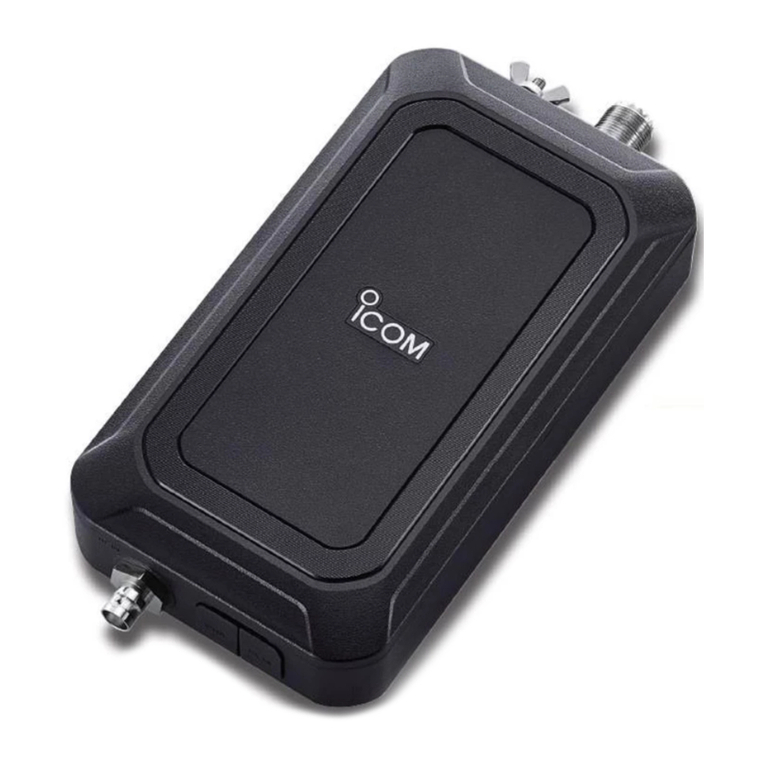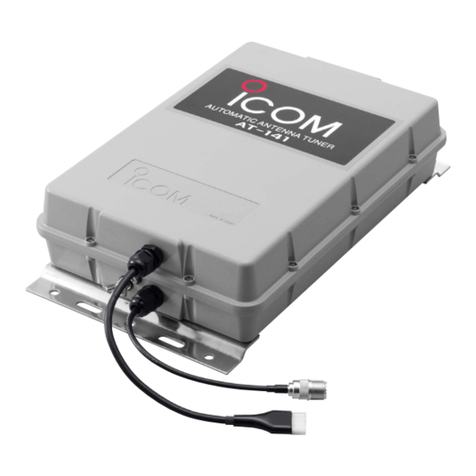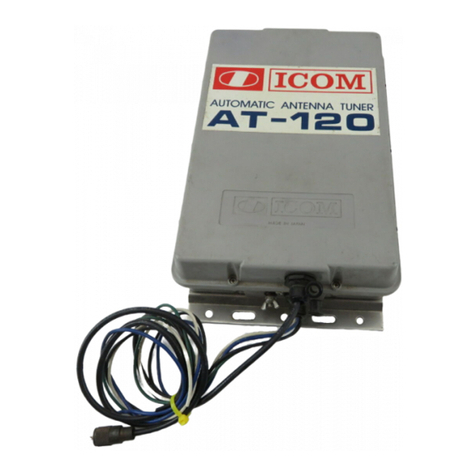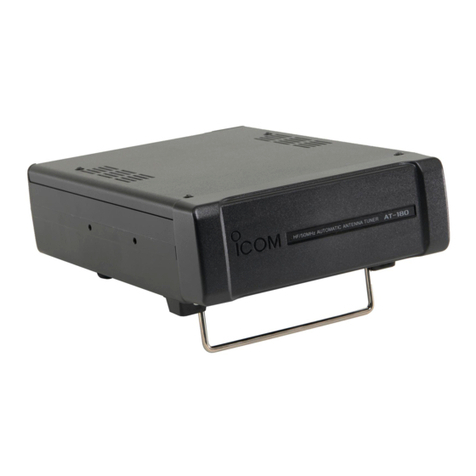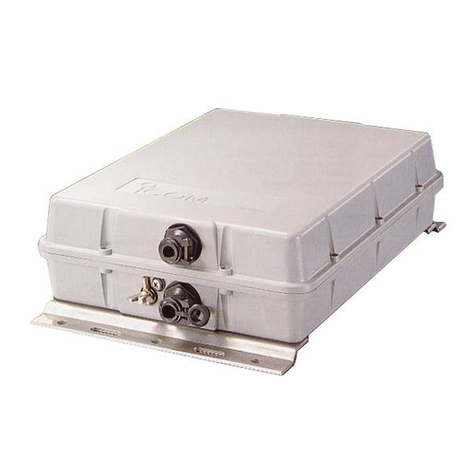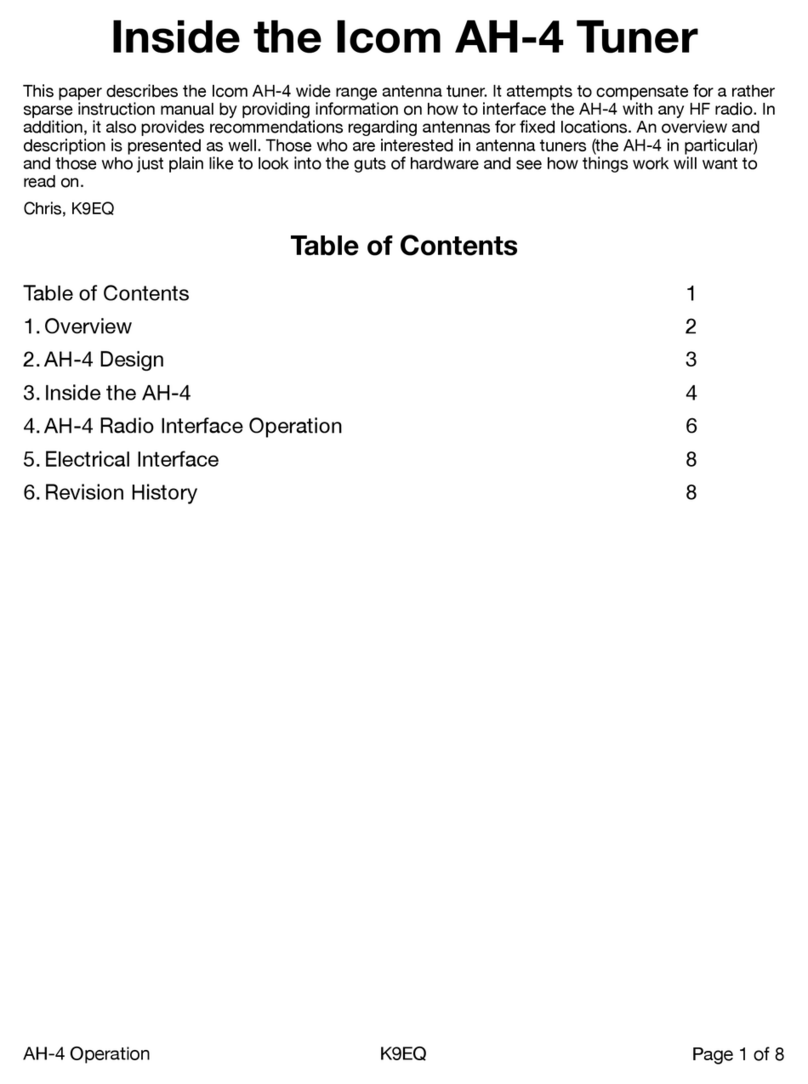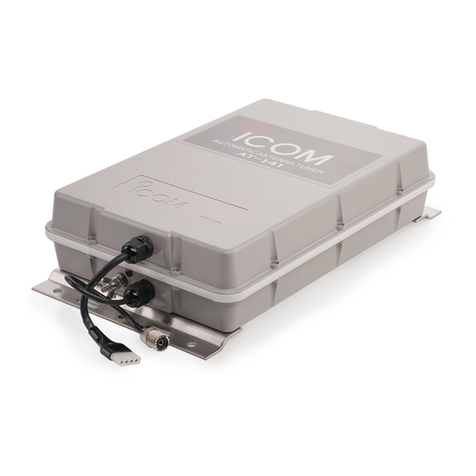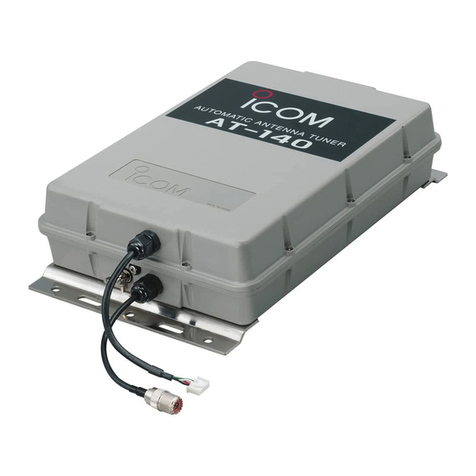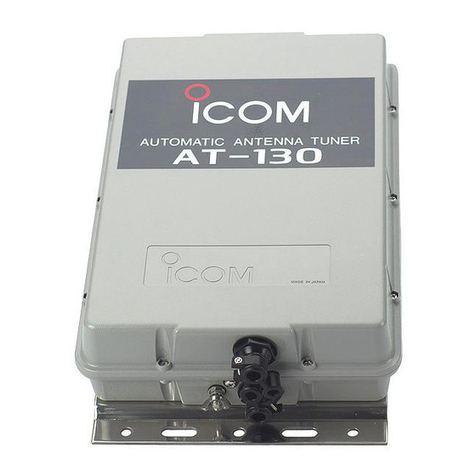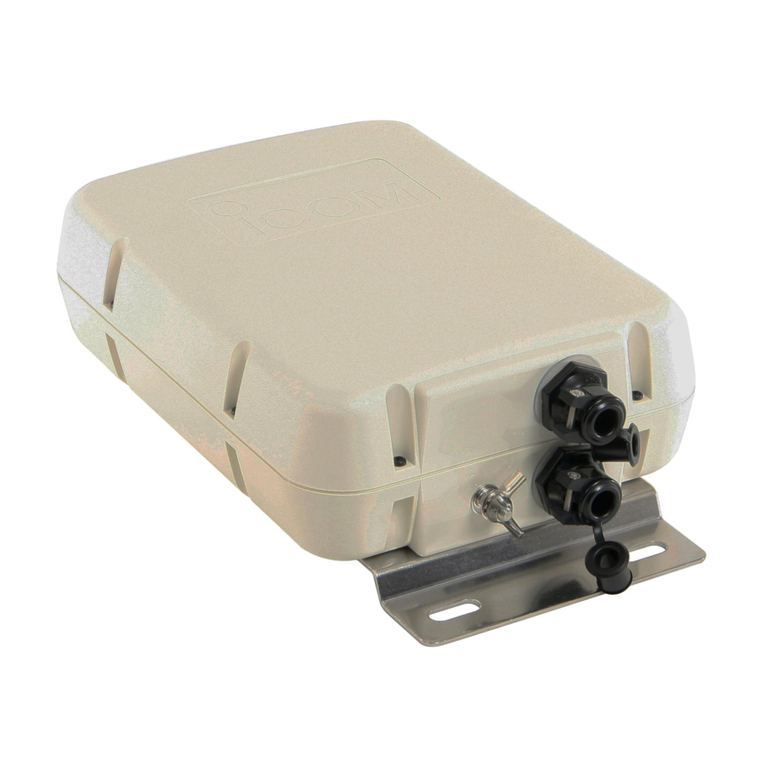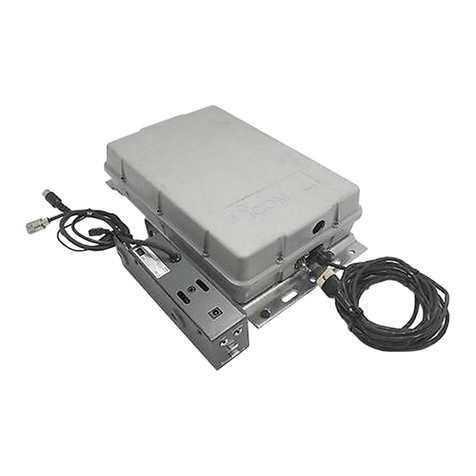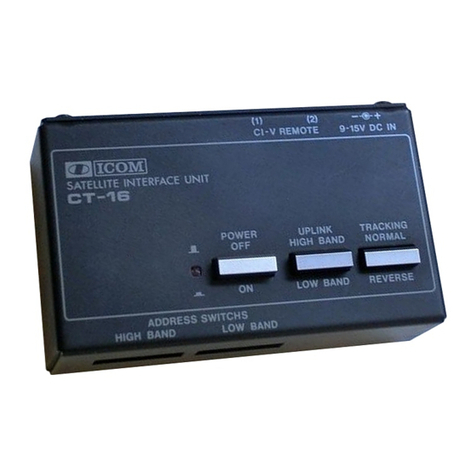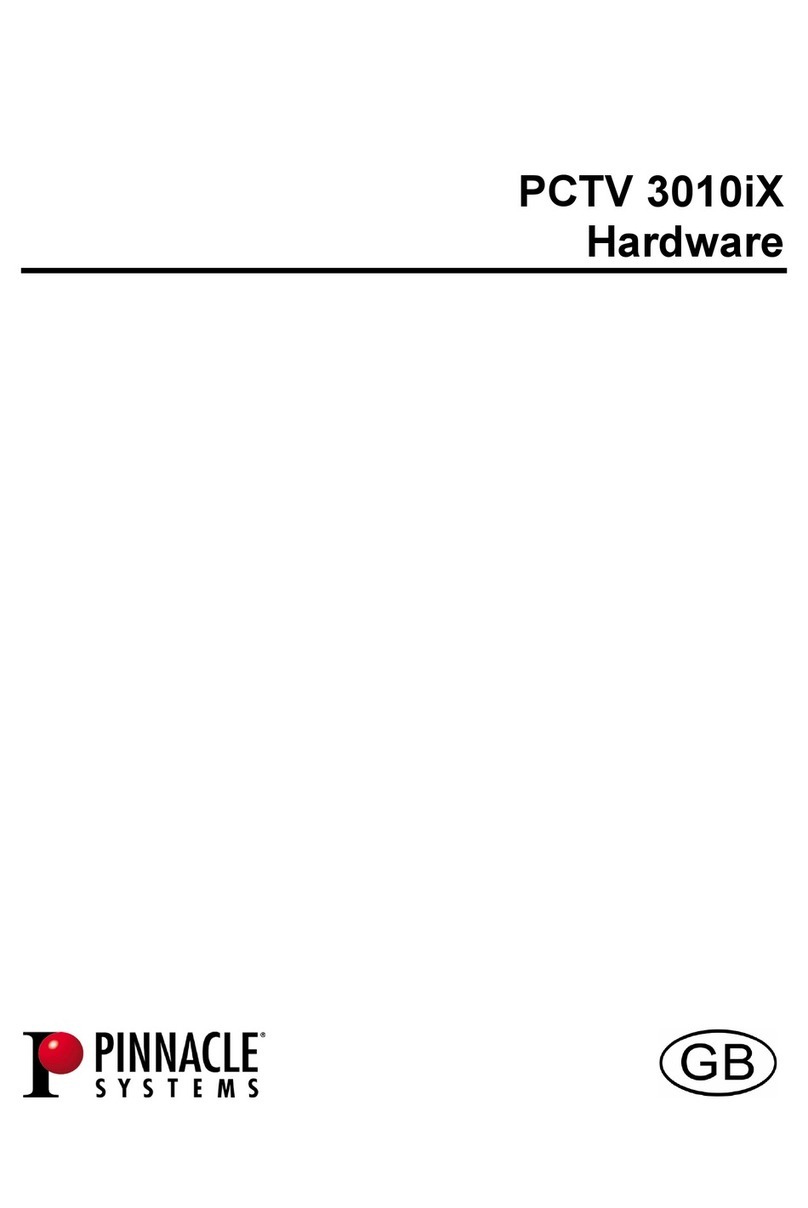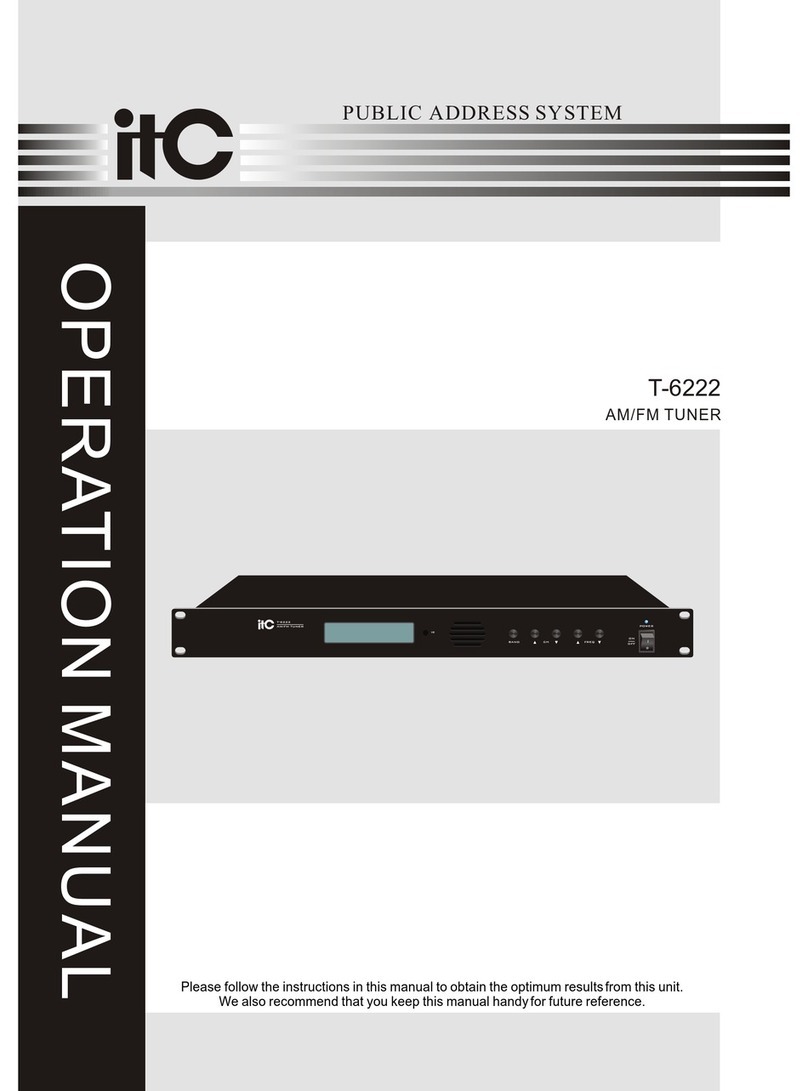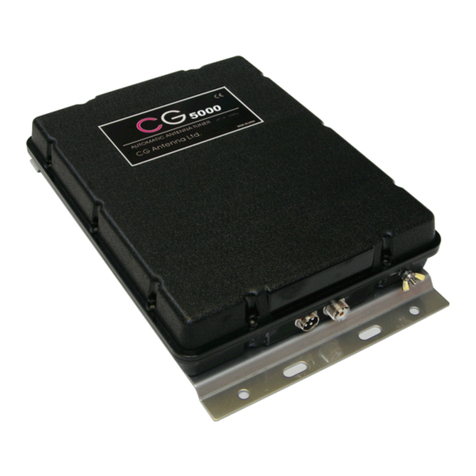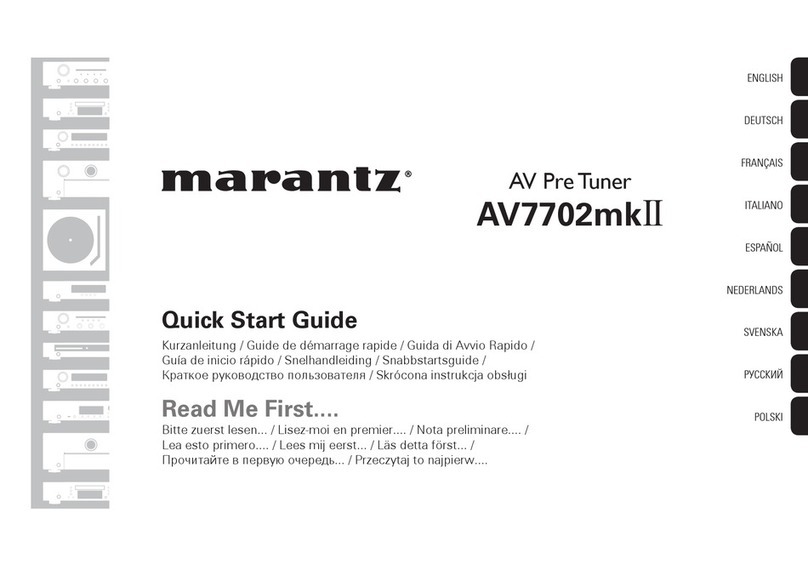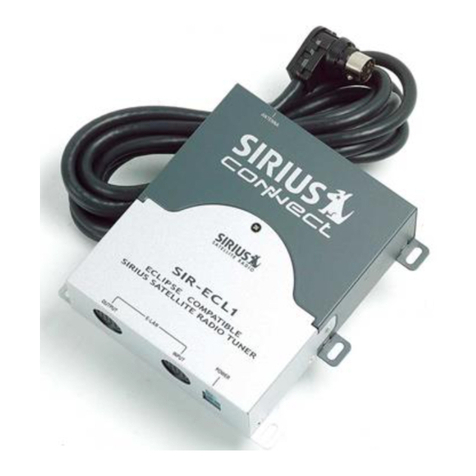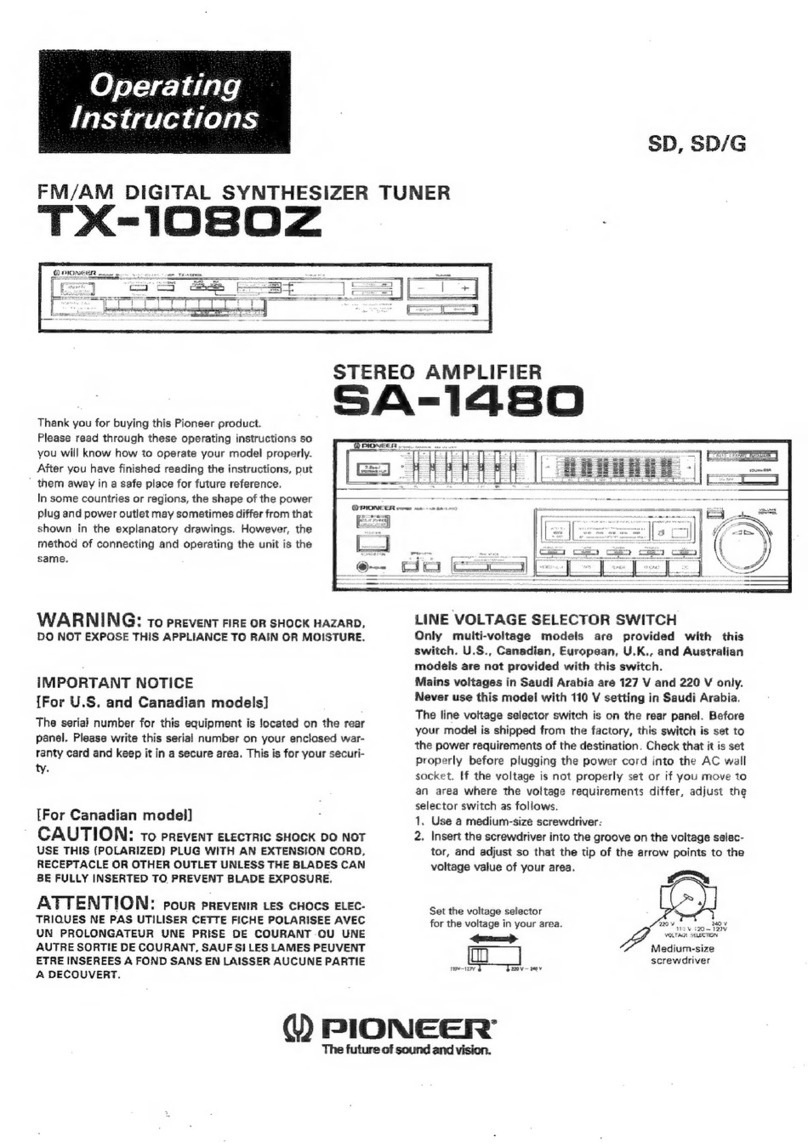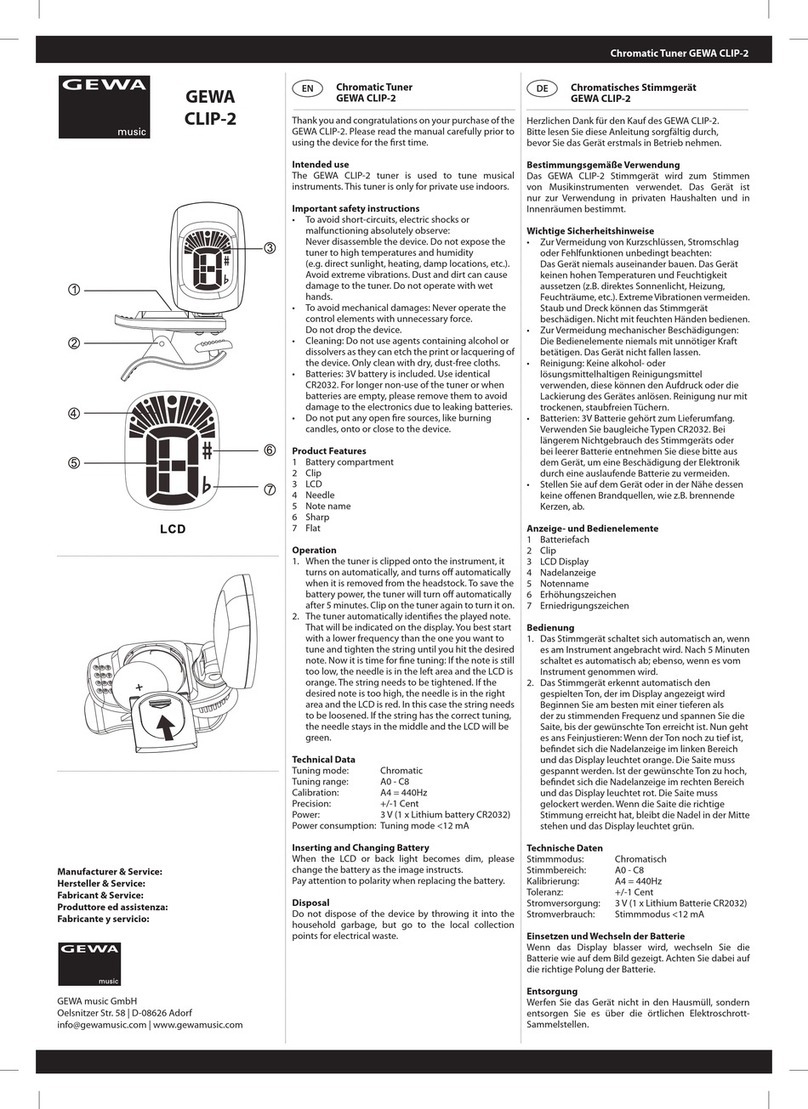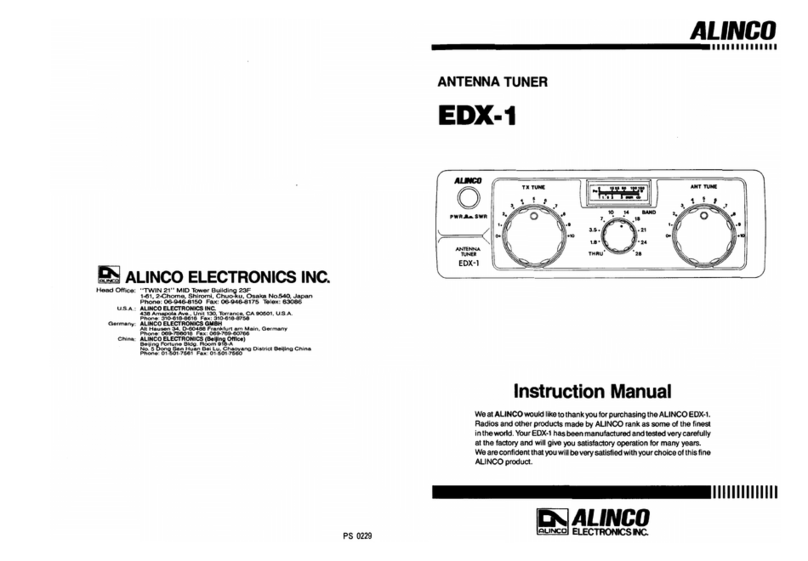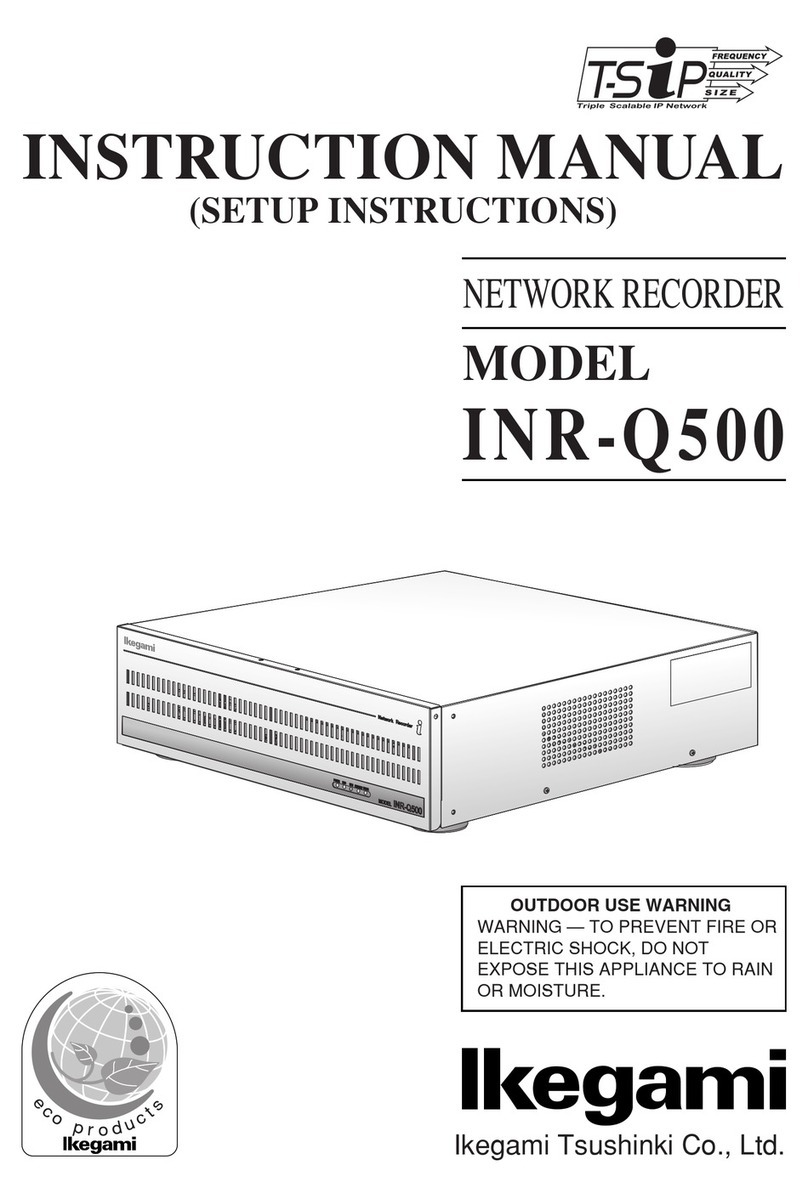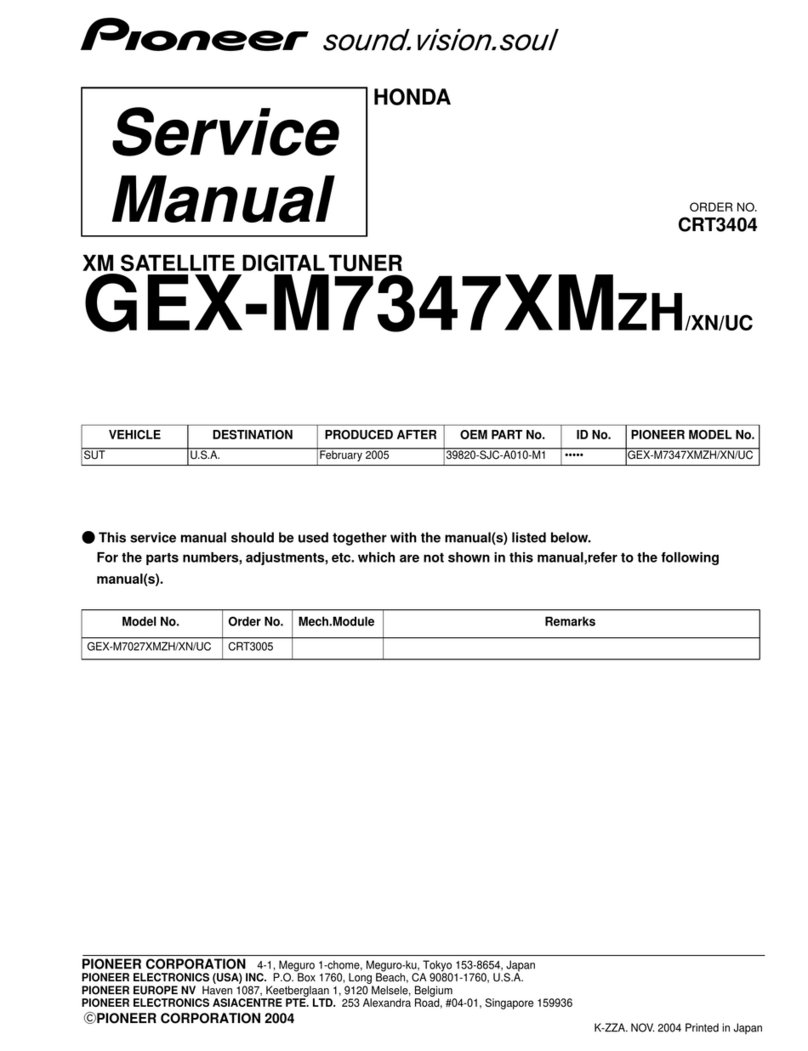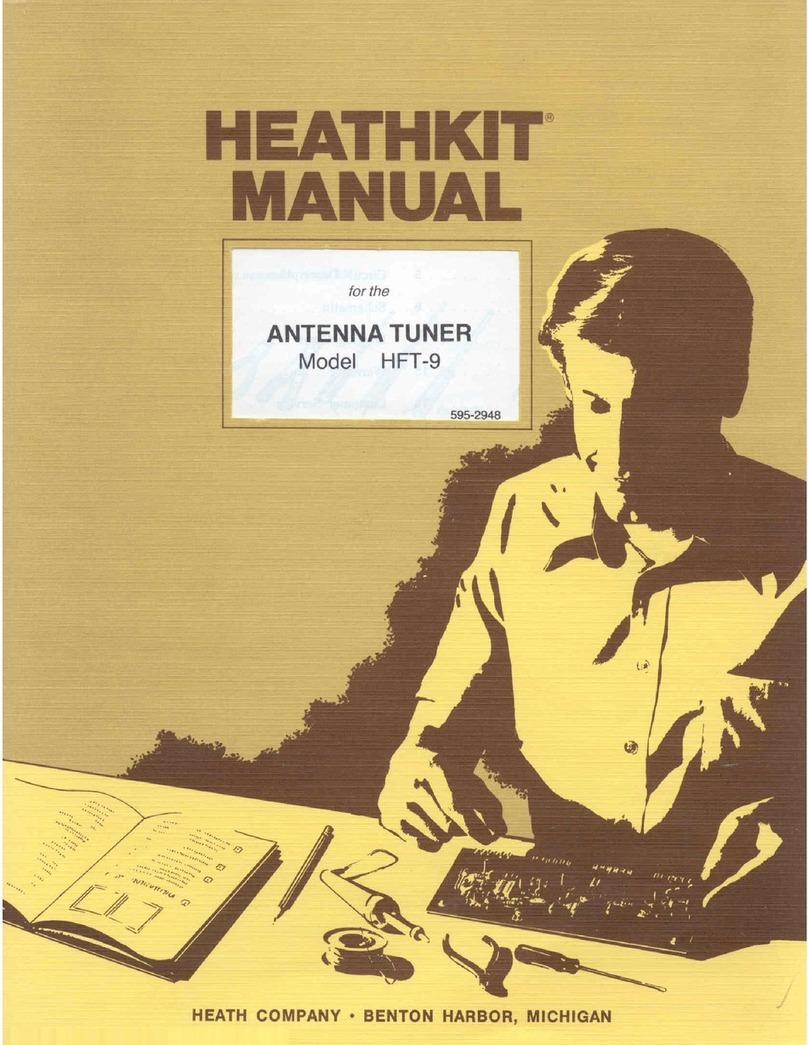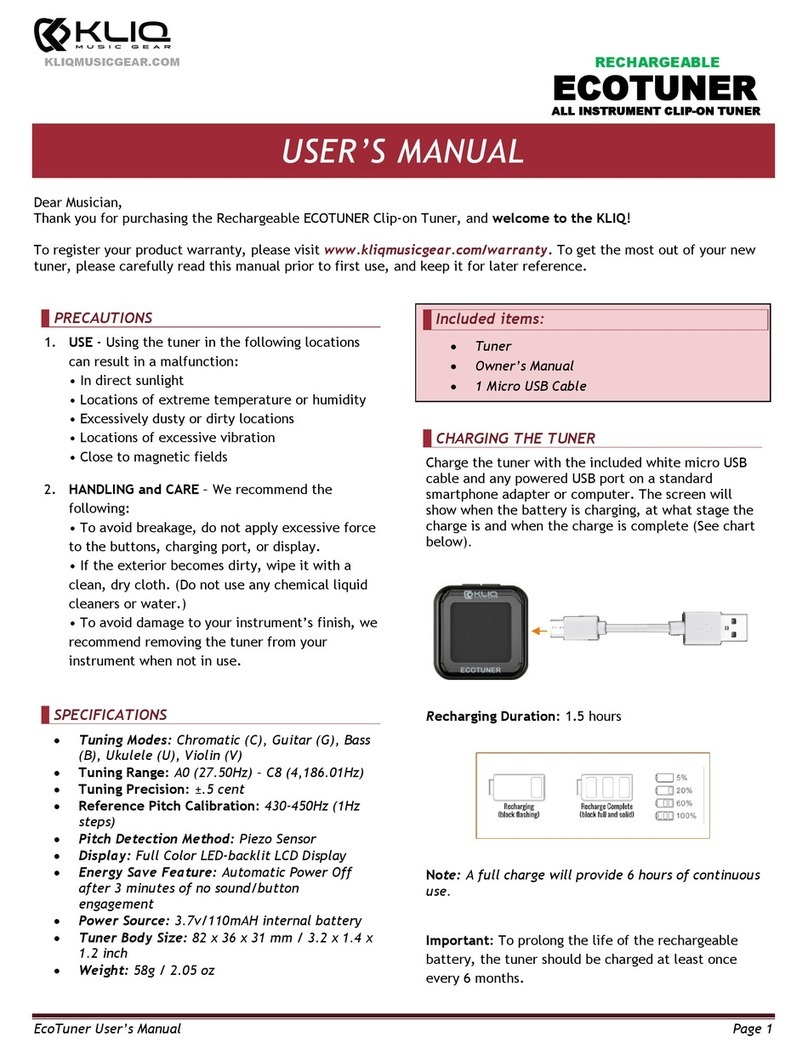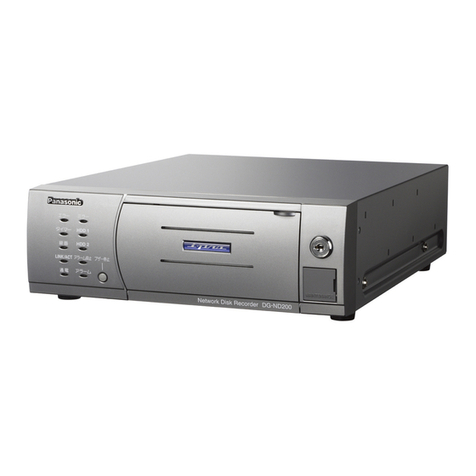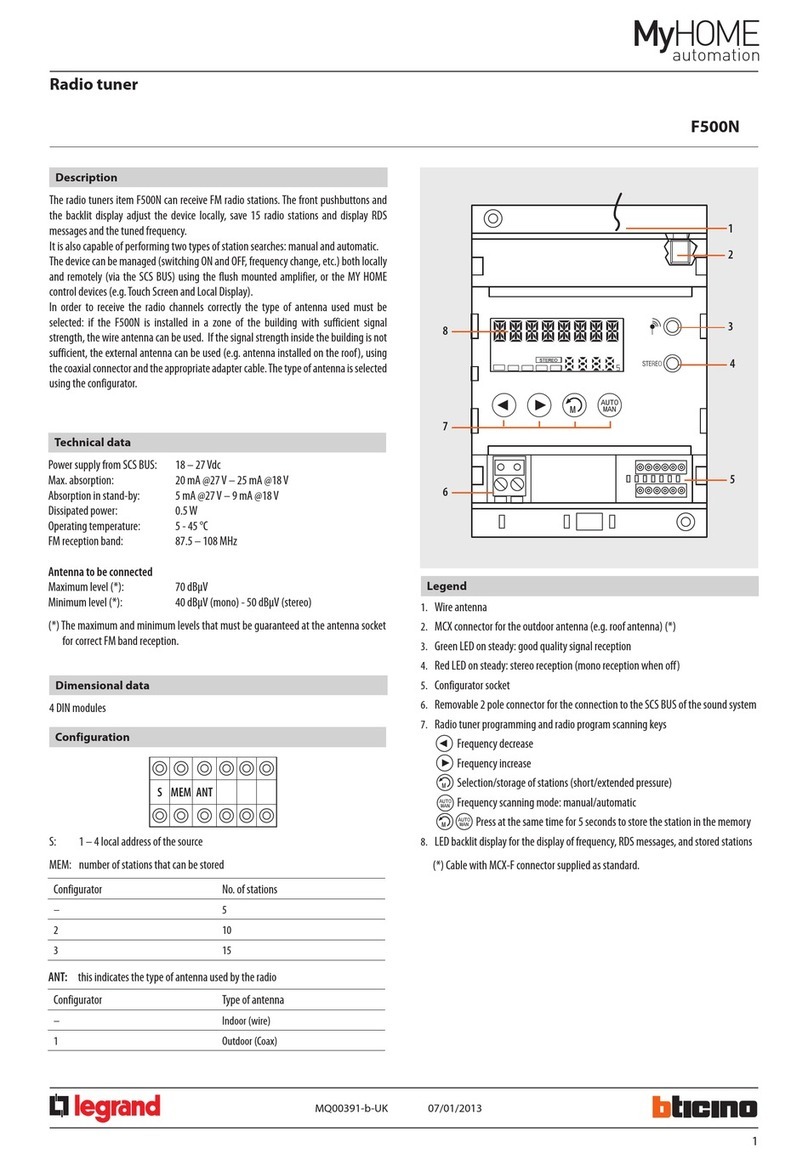Icom AT-130 User manual

HF
AUTOMATIC
ANTENNA
TUNER
AT-130
AT-130E
Icom
Inc.

IMPORTANT
READ
ALL
INSTRUCTIONS
carefully
and
completely
before
using
the
AT-130
and
AT-130E.
SAVE
THIS
INSTRUCTION
MANUAL.
This
instruction
manual
contains
important
safety
and
installation
instructions.
PRECAUTIONS
DANGER
HIGH
VOLTAGE!
NEVER
touch
the
antenna
terminal,
ground
terminal,
antenna
or
counterpoise
while
transmitting.
Place
the
AT-130
or
AT-130E,
antenna
and
counterpoise
in
positions
where
no
one
touches
them.
NEVER
use
without
a
ground
connection.
NEVER
transmit
during
internal
adjustment
to
pre-
vent
electric
shock.
USE
the
ground
terminal
for
ground
connection.
The
mounting
plate
is
not
connected
internally.
Ground
terminal
Mounting
plate
DO
NOT
operate
your
HF
marine
transceiver
without
running
the
boat's
engine.
AVOID
using
the
AT-130
or
AT-130E
in
areas
where
the
temperature
is
below
—30°C
or
above
+60.
EXPLICIT
DEFINITIONS
The
explicit
definitions
in
this
instruction
manual.
WARNING
Personal
injury,
fire
hazard
or
electric
shock
may
occur,
|
CAUTION
|
Equipment
damage
may
occur.
If
disregarded,
inconvenience
only.
No
personal
injury,
fire
hazard
or
electric
shock
will
occur.
FOREWORD
Thank
you
for
purchasing
the
AT-130
or
AT-130E
HF
AUTOMATIC
ANTENNA
TUNER.
The
AT-130
and
AT-130E
are
designed,
primarily
for
use
with
Icom
HF
transceivers.
To
meet
with
Euro-
pean
regulations,
the
AT-130E
includes
an
extra
emergency
tuner
circuit
for
2182
kHz
operation.
Refer
to
your
HF
transceiver
instruction
manual
for
operation.
If
you
have
any
questions,
contact
your
nearest
authorized
Icom
Dealer
or
Service
Center.
UNPACKING
The
following
parts are
supplied
with
the
AT-130/E.
@
U-bolts
@
U-bolt
plates
@
Flat
washers
(M6
large)
@
Flat
washers
(M6
small)
®
Spring
washers
(M6)
©
Nuts
(ME)
.....sesseecseee
@
Hex
head
bolts
(M6
x
50)
®
Self-tapping
screws
(AO
6
X
30)
.
©
Weatherproof
cap
@®
4-pin
connector
@®
Connector
pins
@
Ground
cable
(O!
4HRRO@ORONNS
MISCELLANEOUS
ITEMS
The
following
parts
are
required
for
installation,
but
are
not
supplied
with
the
AT-130
or
AT-130E.
@
AWG
14
x
4-conductor
shielded
cable
*Icom
offers
an
optional
OPC-420
CONTROL
CABLE.
Length:
10
m;
32.8
feet
@
50
Q
coaxial
cable
@
PL-259
connectors

TABLE
OF
CONTENTS
IMPORTANT
..
PRECAUTIONS
accssssssscssssosssssssassssrsesssnessssovesseaes
EXPLICIT
DEFINITIONS.
...........essssssssessssnseneseesesseeseesel
FOREWORD
..
MISCELLANEOUS
ITEMS
........sccsssessesssssserseesseesneeseed
TABLE
OF
CONTENTS
|...
n0iessnsecsssncencssonssnsseensmsonsall
FEATURES
sissisiscicssanrernncrnermninnnes
pinacapenceaseieiinnse
ii
1
ANTENNA
SYSTEM.
WAntenna
for
ship.....
Antenna
for
land
operation
.
Coaxial
cable
............00
Ground
and
counterpoise
2
INSTALLATIONS
Minstallation
outline
.
Cable
installation
MIPL-259
connector
.
Control
cable
..
Cable
connectio:
Mounting
12
PRAwBOOR
NN
3
INTERNAL
SETTINGS
.
Before
internal
settings
Mode
switch
..
Preset
tuning
Emergency
tuning
(AT-130E)
4
CONTROL
CABLE
SIGNALS
Terminal
information
Transceiver
switch
5
INSIDE
VIEW
AND
SPECIFICATIONS
................
Miinside
view..
Specifications
oO
VYN
onuug
FEATURES
Matches
all
bands
The
AT-130/E
matches
any
frequency
on
every
HF
marine
band.
For
example,
the
tuner
matches
a
7
m;
23.0
feet
long-wire
antenna
across
1.6—30
MHz.
Full
automatic
tuning
Just
push
the
[TUNE]
switch
on
a
transceiver,
the
AT-130/E
adjusts
immediately
to
the
minimum
SWR
in
any
frequency
on
any
HF
marine
band.
HF
operation
on
any
size
ship
The
AT-130/E
allows
you
HF
operation
where
antenna
element
length
is
restricted
due
to
space.
Weather
resistant
The
AT-130/E
is
housed
in
a
durable,
completely
weather-
resistant
acrylic
case
with
a
rubber
gasket.
The
antenna
tuner
can
be
conveniently
installed
both
on
the
deck
or
in
the
cabin
near
the
antenna
element.
Simple
installation
Installation
is
simple.
Just
connect
the
control
and
antenna
cables
and
short-time
internal
settings.
After
installation,
you
never
need
to
open
the
cover
for
maintenance.
Preset
tuning
function
This
function
provides
super
fast
tuning
on
your
most-used
frequency.
45
memories
for
shorter
tuning
time
To
decrease
the
tune-up
time,
the
AT-130/E
automatically
stores
the
matching
conditions
for
up
to
45
frequencies.
Retuning
for
a
memorized
frequency
takes
only
approx.
1
sec,
Super
capacitor
for
memory
backup
Even
if
the
AT-130/E
is
not
used
for
approx.
1
week,
the
built-in
super
capacitor
backs
up
the
45
memory
contents.
Low
power
tune
up
The
AT-130/E
emits
low
output
power
during
tuning.
This
feature
reduces
the
possibility
of
causing
interference
to
other
stations.
Emergency
tuner
circuit
(AT-130E)
To
meet
with
European
regulations,
the
Europe
version
AT-130E
includes
an
emergency
tuner
circuit
for
2182
kHz
operation.
If
any
signal
from
the
control
cable
indicates
an
abnormal
condition,
this
circuit
is
automatically
selected.

1
ANTENNA
SYSTEM
Antenna
for
ship
Required
antenna
element
length
Required
antenna
element
length
to
achieve
full
perform-
ance
varies
according
to
the
lowest
frequency:
Required
antenna
element
length
The
lowest
frequency
1.6
MHz
band
7
m;
23.0
feet
or
longer
4
MHz
band
3
m;
9.8
feet
or
longer
The
longer
the
antenna
element,
the
better
the
antenna
efficency.
Undesireable
antenna
element
lengths
AVOID
multiples
of
1/2
(half
wavelength)
for
antenna
element
lengths,
since
tuning
becomes
difficult.
L
:
Antenna
element
length
to
be
avoided
[m]
f
:
Operating
frequency
[MHz]
n
:
Natural
number
(n=
1,
2,
3,
...)
1
=
.
L=
xn
[Example]
At
an
operating
frequency
of
16
MHz,
avoid
the
following
antenna
element
lengths:
300
1
L=
——
x—
Xn
94,
188...
16
2
1m
=
39inches
For
example,
if
15
m
is
selected
for
an
antenna
element
length,
you
have
no
problem
in
1.6—25
MHz
marine
bands.
W
Antenna
for
land
operation
In
some
countries,
HF
transceivers
can
be
used
for
land
mobile
operation.
Ask
your
Icom
Dealer
for
details,
since
the
radio
law
varies
according
to
countries.
For
land
mobile
operation
on
4
MHz
and
above,
an
optional
AH-2b
ANTENNA
ELEMENT
is
available.
The
AH-2b
includes
a
sturdy
tow
hook
mount
system
for
holding
a
2.5
m;
8.2
feet
stainless
steel
antenna
element
plus
all
the
necessary
hardware.
NOTE:
Keep
antennas
as
far
away
from
other
objects
as
possible,
especially
metal
objects.
Refer
to
the
AH-2b
instruction
manual
for
the
AH-2b
and
AT-130/E
installation
to
your
vehicle.
Ask
your
Icom
Dealer
for
details.
Connect
a
suitable
antenna
element
for
a
coastal
station,
To
achieve
full
performance,
refer
to
“Required
antenna
element
length”
above,

WiCoaxial
cable
Insulate
the
lead-in
cable
of
the
AT-130/E
antenna
ter-
minal
and
antenna
element
from
other
metal
objects.
To
prevent
interference,
keep
cables
as
far
as
possible
from
an
antenna,
electric
pump
and
other
electronic
equipment.
WGround
and
counterpoise
Why
ship’s
ground
is
required
The
AT-130/E’s
ground
terminal
MUST
be
connected
to
your
ship’s
ground.
Grounding
prevents
electric
shocks,
interference
to
other
equipment
and
other
problems.
Grounding
also
ensures
effective
signal
transmission.
DANGER!
NEVER
connect
the
ground
terminal
to
the
following
points.
These
connections
may
cause
an
explosion
or
electric
shocks:
—Gas
or
electrical
pipe
—
Fuel
tank
—Oil-catch
pan
BE
CAREFUL.
The
mounting
plate
is
NOT
connected
to
the
AT-130/E’s
internal
ground.
Non-through
mast
is
NOT
electrically
connected
to
sea
water.
Ideal
ground
points
One
of
following
points
is
ideal:
—Ship’s
ground
terminal
—
External
ground
plate
—
External
copper
screen
Good
ground
points
If
electrically
connected
to
sea
water,
one
of
the
following
points
is
usable:
—
Stainless
steel
tuna
tower
—
Stainless
steel
stanchion
—Through
mast
—
Throughhull
—
Metal
water
tank
Undesireable
ground
points
AVOID
the
following
points,
if
possible.
These
connec-
tions
may
cause
noise
or
electrolysis:
—
Engine
block
—
Keel
bolt
Electrolysis
All
ground
cables
from
the
AT-130/E,
HF
transceiver,
etc.
on
your
ship
should
be
connected
to
only
1
ship's
ground.
AVOID
connection
to
2
or
more
points.
Voltage
differ-
ences
between
2
or
more
ship’s
grounds
may
cause
electrolysis.
AVOID
connections
between
dissimilar
metals
where
an
electric
current
is
present.
These
connections
may
cause
electrolysis.
ANTENNA
SYSTEM
1
To
prevent
erroneous
indications,
keep
cables
as
far
away
as
possible
from
the
flux
gate
compass.
Use
suitable
noise
filters
for
alternators,
fluorescent
lights,
etc.
Ask
your
Icom
Dealer
for
details.
Counterpoise
If
your
ship
is
made
of
FRP,
etc.
and
a
good
ship's
ground
is
not
available,
connect
a
counterpoise.
1/4A
radial
for
each band
Ground
terminal
AT-130/E
1/4A
(quater
wavelength)
radial
for
each
band
is
suit-
able
for
a
counterpoise.
Install
the
counterpoise
directly
below
the
AT-130/E’s
ground
terminal.
Insulate
the
ends
of
each
radial
from
other
metal
objects.
Layout
the
radials
horizontally
and
as
straight
as
possible.
L
:
Counterpoise
length
for
the
operating
frequency
[m]
f
:
Operating
frequency
[MHz]
300
1
L=
=
a
[Example]
At
an
operating
frequency
of
16
MHz,
use
a
counter-
poise
with
the
following
length:
300
1
L=
=.
==
=
4.7
[m]
1m
39
inches
Ground
cable
For
the
best
results,
use
the
heaviest
gauge
wire
or
metal
strap
available.
Make
the
distance
between
the
AT-130/E's
ground
terminal
and
ship's
ground
as
short
as
possible,
Supplied
ground
cable
is
usable
for
ground
connection
to
a
through
mast.
Confirm
that
the
through
mast
is
electrically
connected
to
sea
water.

=
2
INSTALLATIONS
Hinstallation
outline
1)
Remove
the
top
cover.
2)
Install
a
control
cable
and
coaxial
cable.
Refer
to
“Cable
installation”
below.
3)
Connect
and
solder
the
PL-259
connector
to
the
coaxial
cable.
®
Refer
to
“PL-259
connector”
below.
4)
Connect
the
control
cable
to
the
AT-130/E.
®
Refer
to p.
4
“Cable
connection.”
5)
Mount
the
AT-130/E
in
the
desired
location.
*
Refer
to
p.
4
“Mounting.”
WCable
installation
1)
Remove
the
10
screws
from
the
top
cover.
Remove
the
top
cover.
2)
Loosen
the
screws
on
both
cable
clamps.
3)
Set
or
remove
the
strain
relief
inserts
corresponding
to
the
diameters
of
the
cables.
4)
Install
the
coaxial
cable
through
the
top
cover
cable
clamp.
Install
the
control
cable
through
the
bottom
cover
cable
clamp.
5)
After
connecting
the
coaxial
cable
and
control
cables,
perform
preset
tuning
setting.
©
For
the
AT-130E,
also
perform
emergency
tuning
setting.
6)
After
internal
adjustments,
tighten
the
cable
clamp
screws,
HIPL-259
connector
1)
Slide
the
coupling
ring
over
the
coaxial
cable.
Strip
the
cable
jacket
and
pull
back
to
reveal
10
mm
of
braid.
*
Soft
solder
the
exposed
braid
and
then
pull
out
the
jacket.
Coupling
[}--30
mi
ke
10
mm
(soft
solder)
2)
Strip
the
cable
as
shown
below.
Tin the
center
conductor
the
entire
length
of
the
exposed
braid.
1-2
mm
oft
solder
10
mm
=
3/8
inches
6)
Connect
an
antenna,
ship's
ground
or
counterpoise.
Refer
to
p.
1
“Antenna
for
ship"
and
p.
2
“Ground
and
counterpoise.”
8)
Connect
the
control
cable
and
the
coaxial
cable
to
the
transceiver.
©
Refer
to
p.
4
“Control
cable.”
9)
Perform
preset
tuning
setting.
For
the
AT-130E,
also
perform
emergency
tuning
setting.
@
Refer
to p.
5
“Preset
tuning"
and
p.
6
“Emergency
tuning.”
10)
Select
the
mode
switch
(S1)
to
NORMAL
mode
(center
position).
Replace
the
top
cover.
3)
Slide
the
connector
body
over
the
cable
and
solder
as
shown
below.
Solder Solder

INSTALLATIONS
2
Control
cable
Between
the
AT-130/E
and
HF
marine
transceiver,
con-
For
an
optional
OPC-420
CONTROL
nect
4
contro!
signal
lines
as
shown
at
right.
To
prevent
To
Icom
HF
marine
CABLE,
you
need
not
assemble
RF
feedback,
use
a
4-conductor
shielded
cable.
Connect
transcelver
supplied
Acpnicp
nec
the
shield
line
to
the
[GND]
terminal
on
the
transceiver.
AT-130
;[E]
Control
cable
Icom
offers
an
optional
OPC-420
CONTROL
CABLE
AT-130E:(ANTC]
(10
m;
92.8
feet).
:
ALY
AT-120/€
Refer
to
p.
7
“Terminal
information”
and
“Transceiver
switch”
for
details.
WiCable
connections
Coaxial
cable
[ANTC]
terminal
in-
stead
of
the
[E]
ter-
minal.
Refer
top,
7
for
details,
Before
connecting
to
terminals,
soft
solder
ends
of
the
cable.
Ship's
ground
=
HiMounting
Attach
the
AT-130/E
either
horizontally
or
vertically
with
one
of
the
water
drains
facing
downwards.
After
mounting,
remove
the
screw
in
the
water
drain.
Mounting
on
a
mast
Using
U-boits
‘Drill
a
hole
here.
Diameter:
7-8
mm;
9/32—5/16
inches
i

—E
INTERNAL
SETTINGS
WBefore
internal
settings
Before
operation,
preset
tuning
setting
and
emergency
tuning
setting
are
required.
What
Is
preset
tuning
Preset
tuning
setting
provides
fast
tuning
on
your
most-
used
frequency.
HiMode
switch
According
to
the
mode
switch
(S1),
the
AT-130/E
oper-
ates
as
follows:
[tose
[Poon]
—__bwecrnion
Used
only
for
preset
tuning.
Refer
reser
|e
_[Svirac
ve
Operates
in
automatic
tuning.
For
NORMAL
|
Center
fast
tune
up,
preset
switches
(S3,
Operates
in
automatic
tuning
only.
OFF
to
This
mode
is
for
some
non-lcom
HF
wer
|
transceivers,
Refer
to
p.
7
for
de-
tails.
‘$4,
$5)
information
is
also
used.
After
internal
settings
are
performed,
select
the
mode
switch
(S1)
to
NORMAL
mode
(center
position).
Preset
tuning
1)
Connect
a
SWR
meter
between
an
HF
transceiver
and
the
AT-130/E.
2)
Confirm
the
mode
switch
(S1)
is
in
NORMAL
mode
(center
position).
3)
Select
your
most-used
operating
frequency.
4)
Push
the
[TUNE]
switch
on
the
HF
transceiver.
®
When
the
AT-130/E
succeeds
in
automatic
tuning,
an
LED
(DS24)
lights
up.
©
Confirm
that
SWR
reading
is
less
than
2:1.
5)
Make
a
note
of
which
LED's
(DS1
—DS23)
light
up.
6)
Select
S1
to
PRESET
mode
(upper
position).
7)
Select
the
preset
switches
(S3,
S4,
S5)
so
that
the
same
LED's
light
up
as
in
step
5).
8)
Select
S1
to
NORMAL
mode
(center
position).
What
Is
emergency
tuning
The
Europe
version,
AT-130E,
includes
an
emergency
tuner
circuit
for
2182
kHz
operation
separated
from
the
automatic
tuner
circuit.
If
any
signal
from
the
control
cable
becomes
abnormal,
the
emergency
tuner
is
auto-
matically
selected,
Mode
switch
(S1)
location
9)
Replace
the
top
cover
of
the
AT-130.
For
the
AT-130E,
perform
emergency
tuning
settings.
Switch
and
LED
locations
000000
|900000
32-8
0
[s36
sai
[s4—0
051s
|s5—0
oss

INTERNAL
SETTINGS
3
Emergency
tuning
(at-130E)
For
the
AT-130E,
before
operation,
perform
emergency
tuning
setting.
4)
Disconnect
the
13.6
V
DC
cable
from
the
[13.6]
terminal.
Tape
the
end
of
the
wire,
¢
NEVER
allow
the
13.6
V
DC
cable
end
to
touch
any
other
parts,
5)
Disconnect
all
4
pins
on
J2
as
shown
below.
6)
Connect
a
red
wire
to
a
pin
(J7-J22)
where
minimum
SWR
reading
is
obtained.
1)
Connect
an
SWR
meter
between
an
HF
transceiver
and
the
AT-130E.
7)
Connect
pins
on
J2
to
obtain
a
minimum
SWR
reading.
2)
Remove
the
top
cover
of
the
AT-130E.
8)
Adjust
C8
to
obtain
a
minimum
SWR
reading.
3)
Select
2182
kHz
and
AM
(H3E)
mode
for
the
HF
*
To
avoid
damage
to
the
HF
transceiver,
DO
NOT
transmit
transceiver.
for
more
than
5
sec.
©
Refer
to
each
transceiver's
instruction
manual
for
d
9)
Repeat
steps
6)—8)
to
obtain
a
minimum
SWR
reading.
10)
Connect
the
13.6
V
DC
cable
to
the
[13.6]
terminal.
11)
Replace
the
top
cover
of
the
AT-130E.
13.6
V
DC
cable
Red
cable
layout
Connect
to
a
pin
(J7—J22)
where
a
minimum
SWR
reading
is
obtained.
Layout
the red
cable
as
shown.
Disconnect
13.6
V
DC
cable
from
the
[13,6]
terminal.
Connect
af-
ter
manual
tuning.
Adjust
C8
to
ob-
tain
=
minimum
SWR
reading.
J2
location.
Refer
to
Selectable
pin
connections
on
J2
below
left
for
details,
Select
one
of
following
pin
connections
to
obtain
minimum
SWR
reading.
Pin
connection
be-
fore
shipping
from
Icom.
Disconnect
all
4
pins
on
J2
in
step
5)
above.

mm
64
=
«=coNTROL
CABLE
SIGNALS
WTerminal
information
Consider
the
following
points
when
using
a
non-lcom
Start
voltage
[STAR]
transceiver.
When
start
voltage
(less
than
1
V)
is
received,
the
AT-130/E
begins
automatic
tuning.
More than
50
msec.
No
connection.
AT-130E:
Antenna
current
detector
output
from
the
emergency
tuner.
13.6
V
DC
@
input
terminal.
Max.
current
drain
2A
The
same
voltage
as
the
ground
terminal
at
the
bottom.
No
need
to
connect
from
this
terminal.
Receives
start
voltage.
Key
voltage
[KEY]
Max.
current
drain
100
mA
During
automatic
tuning,
the
AT-130/E
grounds
key
voltage
line,
and
the
HF
transceiver
reduces
output
Key
voltage.
Grounded
during
tuning.
power.
Max,
current
drain
100
mA
During
automatic
tuning
If
the
key
voltage
is
more
than
8
V,
select
the
mode
switch
(S1)
to
OFF
mode
(lower
position).
NORMAL
mode
——j———
OFF
mode
si
°
@
Transceiver
switch
IC-M700
with
serial
numbers
2500
and
below
Other
Icom
HF
transceivers
In
the
IC-M700,
change
the
[TUNE]
switch
setting
from
Some
Icom
HF
transceivers
have
internal
[KEY]
and
the
“1"
position
to
the
“2”
position.
Confirm
that
the
[KEY]
[TUNE]
switches.
Suitable
switch
settings
for
the
switch
is
in
the
“2”
position.
Refer
to
the
IC-M700
instruc-
AT-130/E
are
performed
before
shipping.
tion
manual
p.
9
for
details.
However,
if
a
non-Icom
automatic
tuner
was
previously
used,
confirm
the
switch
settings.
Refer
to
the
instruction
{KEY}
[TUNE]
manual
for
details.
‘Confirm
*2"
position.
Non-Icom
HF
transceivers
Laue
Select
correct
settings
for
the
start
voltage
and
key
Select
“2”
position.
voltage.
Refer
to
your
HF
transceiver
instruction
manual
for
details.

INSIDE
VIEW
AND
SPECIFICATIONS
5
Hlinside
view
jency
tuner
'
s
Antenna
terminal
(AT-130E
only)
DS1-DS23
LED's
Control
cable
terminals
$1
Mode
switch
DS24
LED
$3
Dip
switch
$4
Dip
switch
$5
Dip
switch
J1
Antenna
connector
Ground
terminal
=
2
=
'‘*———_
Mounting
plate
WSpecifications
¢
Dimensions
:
230(W)
xX
340(H)
x
80(D)
mm
9.1(W)
X
13.4(H)
X
3.1(D)
in
(projections
not
included)
©
Weight
:
AT-130
2.5
kg;
5.5
|b
AT-130E
2.7
kg;
6.0
Ib
«Usable
temperature
range
:
—30°C
to+60
«Power
supply
requirement
:
13.6
V
DC
(supplied
from
HF
transceiver)
©
Current
drain
:
Max.2A
¢
Frequency
coverage
:
1.6—30
MHz
(with
7
m;
23.0
feet
or
longer
antenna
element)
Input
impedance
:
50Q
«Max.
input
power
:
150
W
(PEP)
100
W
(continuous)
«
Automatic
tuning
time
:
Approx.
2—3
sec.
(general
condition)
|
Max.
15
sec.
Approx.
1
sec.
(retuning
for
a
memorized
frequency)
©
Automatic
tuning
accuracy
:
SWR
2.0:1
(after
tuning,
except
for
multiples
of
1/2)
All
stated
specifications
are
subject
to
change
without
notice
or
obligation.

Count
on
us!
A-8163S-1EX-
Printed
in
Japan
Icom
Inc.
Copyright
©
1992
by
Icom
Inc.
6-9-16,
Kamihigashi,
Hirano-ku,
Osaka
547,
Japan
Other manuals for AT-130
4
This manual suits for next models
1
Table of contents
Other Icom Tuner manuals
